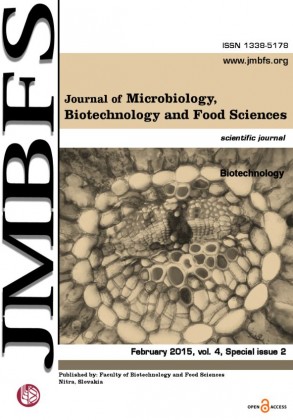THE USE OF DIFFERENT PROTEASES TO HYDROLYZE GLIADINS
DOI:
https://doi.org/10.15414/jmbfs.2015.4.special2.101-104Keywords:
Gliadins, proteases, celiac diseaseAbstract
Gliadins represent alcohol-soluble fraction of wheat storage proteins which is responsible for development of celiac disease. The only and effective treatment for celiac disease is strict adherence to a gluten-free diet excluding any food made with wheat, as well as rye, barley and possibly oat flour. Enzymatic modification of wheat gliadins seems to be an alternative method for decreasing of celiac activity. The aim of our study was a trial of enzymatic modification of wheat gliadins using fungal (Aspergillus sp., Aspergillus oryzae, Aspergillus niger) and bacterial (Bacillus licheniformis, Bacillus stearothermophilus, Bacillus thermoproteolyticus, Streptomyces griseus) proteases. The reaction was performed up to 60 min, stopped by addition of appropriate synthetic inhibitor and products of limited proteolysis were analyzed by SDS-PAGE method. From fungal proteases most effective proteolytic activity was observed using acid proteinase from A. niger since wheat gliadins and low molecular weight peptides were completely degraded. Bacterial proteases form B. licheniformis and B. thermoproteolyticus acted very effective and as the result of hydrolysis, the products of lower molecular weight (<15 kDa) occurred. Most of the wheat gliadins were susceptible to proteolysis by examined bacterial enzymes (exception were protease from B. stearothermophilus and S. griseus). Although wheat gliadins are susceptible to enzymatic degradation, further analysis (e.g. immunochemical or mass spectrometry) are desirable to confirm if the products of proteolysis have lost or at least partially decrease their celiac activity.Downloads
Download data is not yet available.
Downloads
Published
2015-02-02
How to Cite
Socha, P., Mickowska, B., Urminská, D., & KaÄmárová, K. (2015). THE USE OF DIFFERENT PROTEASES TO HYDROLYZE GLIADINS. Journal of Microbiology, Biotechnology and Food Sciences, 4(special issue 2 (Biotechnology), 101–104. https://doi.org/10.15414/jmbfs.2015.4.special2.101-104
Issue
Section
Biotechnology
License
Copyright (c) 2015 Peter Socha, Barbara Mickowska, Dana Urminská, Kvetoslava KaÄmárová

This work is licensed under a Creative Commons Attribution 4.0 International License.
All papers published in the Journal of Microbiology, Biotechnology and Food Sciences are published under a CC-BY licence (CC-BY 4.0). Published materials can be shared (copy and redistribute the material in any medium or format) and adapted (remix, transform, and build upon the material for any purpose, even commercially) with specifying the author(s).





